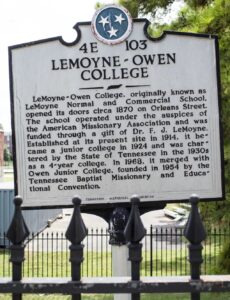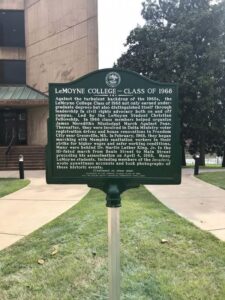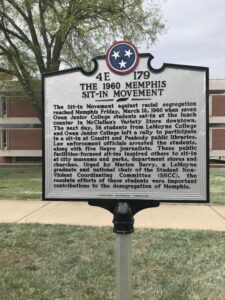
INTRODUCING MY MEMPHIS BLACK STUDENTS IN THE LATE 1960S
In 1966, I moved to Memphis, Tennessee, to teach at Southwestern at Memphis (now Rhodes College), a Presbyterian college. Frustrated with the local Presbyterian church’s failure to address the challenges of the Civil Rights movement, I chose to volunteer at LeMoyne College, a local historically Black college, to better understand the lives and experiences of Black people. I taught Introduction to Bible and Philosophy for three semesters at LeMoyne, and, needless to say, it was both an eye-opening and profoundly enriching experience for me.
LeMoyne College, like many historically Black colleges, was slightly behind its white counterparts at that time. The faculty was mainly white, while the administration was mostly Black. The academic standards were also noticeably lower than those at the white institutions I knew. Needless to say, I initially felt pretty out of place among a student body and faculty that were mainly Black. However, I had to adjust when switching from teaching at an almost all-white school, which I still was, to an almost entirely Black school. The social dynamics and skills of the two groups of students differed significantly, but overall, everything went well, and I learned a great deal, both about myself and about Black students. I even got to play in the Faculty vs. Students basketball game.
What mattered most to me, however, was the friendships I formed with some of my LeMoyne students. I built a friendship with David Merrick, the captain of the basketball team, who was also in my class. A few times, we would shoot hoops together after school. Additionally, two young women in my LeMoyne class, Ethelyn Harris and Joanne Johnson, happened to live nearby, so I asked if they wanted to ride to school with me on class days. As we traveled through the streets of Memphis, I noticed we received more than the usual number of second looks.
What mattered most to me, however, was the friendships I formed with some of my LeMoyne students. I built a friendship with David Merrick, the captain of the basketball team, who was also in my class. A few times, we would shoot hoops together after school. Additionally, two young women in my LeMoyne class, Ethelyn Harris and Joanne Johnson, happened to live nearby, so I asked if they wanted to ride to school with me on class days. As we traveled through the streets of Memphis, I noticed we received more than the usual number of second looks.
One of the highlights of my time with these students was when I invited them, along with one of my all-white Southwestern classes, to a social evening at my home. Both groups greatly enjoyed socializing, and the white students loved learning to do some of the special “Black” dance moves, like the “Booga-Lou” and the “Shotgun.” I don’t think any of my white neighbors even noticed that my party was mixed race. At least, no one ever mentioned that evening get-together. In those days and that place, things were quite clearly segregated. I considered myself very fortunate to have been allowed to “cross,” even if only for a little while, from one side to the other.
An even greater opportunity to navigate the “color-line” arose when one of the few Black students at Southwestern, a young woman named Paula Briggs, was assigned as my student typist. Since I was nearly the only Southwestern faculty member trying to publish scholarly journal articles, Paula was assigned to assist me because of her excellent typing skills. She was remarkably skilled at typing and at deciphering my manuscripts. During her breaks from typing, we occasionally discussed racial issues as well as personal matters.
After my brief time at LeMoyne College, I took all my students from both years, along with Paula from Southwestern, to the Amusement Park, which had only opened to Black people that very year. We had a great time on the rides and ignored the stares from white folks who had never seen Black folks blending with the white crowd before. I often think back to those days and the richness they brought to my life through my very special Black students. I have, of course, had many other Black students at various schools and across different decades, but naturally, these young people in Memphis will always remain especially memorable to me. Sadly, this is a drama that continues to unfold in our country.
(Editor’s Postscript: Here are two historical markers placed at LeMoyne-Owen College where Jerry volunteered.)

This inscription reads:
“Against the turbulent backdrop of the 1960s, the LeMoyne College Class of 1968 not only earned under-graduate degrees but also distinguished itself through leadership in civil rights advocacy both on and off campus. Fellowship, in 1966 class members helped organize James Meredith’s Mississippi March Against Fear. Thereafter, they were involved in Delta Ministry voter registration drives and house renovations in Freedom City near Greenville, MS. In February, 1968, they began marching with Memphis sanitation workers in their strike for higher wages and safer working conditions. Many were behind Dr. Martin Luther King, Jr. in the ill-fated march from Beale Street to Main Street preceding his assassination on April 4, 1968. Many LeMoyne students, încluding members of the Invaders, wrote eyewitness accounts and took photographs of these historic events.”

The inscription reads:
“The Sit-In Movement against racial segregation reached Memphis Friday, March 18, 1960 when seven Owen Junior College students sat-in at the lunch counter in McClellan’s Variety Store downtown. The next day, 36 students from LeMoyne College and Owen Junior College left a rally to participate in a sit-in at Cossitt and Peabody public libraries. Law enforcement officials arrested the students, along with five negro journalists. The public facilities-focused sit-ins inspired others to sit-in at city museums and parks, department stores and churches. Urged by Marion Barry, a LeMoyne graduate and national chair of Student Nonviolent Coordinating Committee (SNCC), the resolute efforts of these students were important contributions to the desegregation of Memphis.”
2 responses to “INTRODUCING MY MEMPHIS BLACK STUDENTS IN THE LATE 1960S”
And we were still having race riots in St. Pete years after all this. it happened slowly and sporadically in the South.
Hey David – I’ve often wondered how parallel the Finnish people’s attitude toward Gypsies is to ours toward Blacks. Thanks for writing. Paz, Jerry